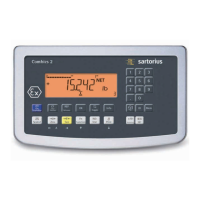Operating Instructions Combics CAIXS2 31
Configuring Weighing Platforms
Entering Adjustment and Linearization Weights
Purpose Entering adjustment and linearization weights.
Setup information – The Service mode must be activated in order for linearization weights to be
entered under menu items 1.18.2 to 1.18.5 (see page 17).
– Adjustment and linearization weights are entered in the Setup menu under
WP-1 for the first weighing platform and under COm1 / WP-2 for the second
weighing platform. The settings are made in the corresponding Setup menu
under menu item 1.18.
– The Service mode does not have to be activated in order for external user-
defined adjustment weights to be entered under menu item 1.18.1.
– The adjustment and linearization weights must be entered in the unit selected
for the ADC configuration under menu item 11.8.
Procedure t Activate the Service mode (only necessary if linearization weights are going to
be entered).
t Select the weighing platform.
t Enter the external user-defined adjustment weight under menu item 1.18.1.
t Enter the external linearization weight under menu items 1.18.2 to 1.18.5.
Menu structure for entering the adjustment and linearization weights
MAN.EXT.W enter the adjustment and linearization weights 1.18
lCAL.ADJ enter external user-defined adjustment weight (Service mode not required) 1.18.1
LIN. WT.1 enter lin. weight 1 1.18.2
LIN. WT.2 enter lin. weight 2 1.18.3
LIN. WT.3 enter lin. weight 3 1.18.4
LIN. WT.4 enter lin. weight 4 1.18.5
Function Allocation of the J Key
Purpose The J key is normally used for the calibration/adjustment function. For detailed
information about calibration and adjustment, see “Operation" starting on page 47.
The following additional functions can be allocated to the key when the Service
mode is activated:
– external linearization with default weights (menu item 1.9.6)
– external linearization with the linearization weights (menu item 1.9.7) entered
under menu item 1.18
– internal linearization (menu item 1.9.5)
– set preload (menu item 1.9.8) (only possible if not required for use in legal
metrology)
– delete preload (menu item 1.9.9) (only possible if not required for use in legal
metrology).
3
Once linearization has been completed, or after a preload has been set or deleted,
the function of the J key must be reallocated back to its original function in the
Setup menu, e.g. external calibration/adjustment with default weights (setup, menu
item 1.9).
Menu structure for the function allocation of the J key
CAL.ADJ calibration, adjustment 1.9
CAL.EXT. calibration/adjustment with default weights (Service mode not required) 1.9.1
CAL.E-USR. calibration/adjustment with user-defined weights
(entered under 1-18, Service mode not required) 1.9.3
LIN.INT internal linearization 1.9.5
LIN.EXT. external linearization with default weights 1.9.6
LINE.USR external linearization with user-defined weights (entered under 1.18) 1.9.7
SET.PREL. set the preload (only possible when used in non-legal metrology) 1.9.8
DEL.PREL. delete the preload (only possible when used in non-legal metrology) 1.9.9
blocked key blocked 1.9.10

